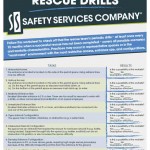Safety School: Emergency Response Plans for Permit Required Confined Spaces
November 6th 2014
- Safety Culture
- Safety Training
Here are four basic questions to check that your emergency response plan for permit required confined spaces is complete.
- Do you have a rescue team standing by every time someone enters a confined space where the atmosphere either is or could turn into an Immediately Dangerous to Life and Health (IDLH) atmosphere?
- Otherwise, does the sum of the time for the emergency response team from notification to rescue equal less than the amount of time the person must be rescued in?
- When was the last time the emergency response team practiced a rescue?
- If you don’t have a trained response team, have you checked that the one you are going to rely on know how to perform possible rescues?
These four questions are just some of the emergency response variables that employers need to address before sending a worker down into a permit space, and the included documents help you ask them all.
This is all created from the part of Permit-Required Confined Spaces regulation for Rescue and Emergency Services, 1910.146(k), and Appendix F that explains how to fulfill that part. First don’t disregard the appendix because it is too complicated or non-mandatory. An appendix serves as an explanation on how to meet some of the more complicated or technical requirements, so if you aren’t 100% sure what to do, following those procedures correctly is the easiest road to being legal.
In addition to having a plan for the attendant to try to extract the entrant without entering (e.g. harness and winch) there needs to be a plan to call for rescue and emergency help. 1910.146(d)(9) The appendix drives this home with the frank advice: “Merely posting the service’s number or planning to rely on the 911 emergency phone number to obtain these services at the time of a permit space emergency would not comply with paragraph (k)(1) of the standard.”
The appendix breaks this evaluation up into two parts: first an initial evaluation of the plan being considered, then a periodic performance evaluation once a plan has been established. The first PDF “Initial Evaluation of Confined-Space Rescue Plans” covers the first part, and the second PDF “Performance Evaluation of Confined-Space Rescue Plans” covers the first half of the second part. I’ve broken out a separate PDF called “Planning Confined-Space Rescue Drills” for the second half.
Initial Evaluation of Confined Space Rescue Plans
Why posting a phone number to the local fire department isn’t enough is because OSHA wants an employer to evaluate – 1910.146(k)(1)(i) – the rescuer’s response times and ability to rescue entrants from identified permit spaces. This table provides the framework to do that.
A “no” in response to any of these questions, and you may have to go back to the drawing board to find another approach.
Performance Evaluation of Confined Space Rescue Plans
The second PDF is a checklist of ongoing confined space rescue plan that involves relying on trained employees. This can be completed immediately after a drill or rescue, and like the first one, a “no” means something needs to be fixed.
Planning Confined Space Rescue Drills
An established team needs to experience a rescue attempt at least

Other Safety School articles that examine the more academic concepts of occupational safety:
- OSHA Inspections
- Contact Release Training for NFPA 70E 2015
- Scaffolding Code of Safe Practices
- Emergency Response Plans for Permit Required Confined Spaces
- Spotlighting the Importance of Checklists
- Details of a Fully Developed Emergency Action Plan
- The Six Guiding Principles of an Industrial Hygienist
- Exactly How Does A Safety Manual Protect Your Company in an Inspection?
- Who Is Covered (Or Not) By OSHA
Disclaimer: This content is for informational purposes only and may not reflect current regulations, best practices, or legal requirements. While accuracy was intended when published, some laws and standards may have changed. Do not rely on it as legal or professional advice.
For guidance specific to your situation, consult a legal professional or refer to the latest regulations. If you have questions or need assistance with additional compliance matters, our team is here to help.

